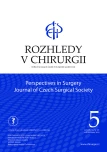Appendicolith as a cause of late complications after appendectomy – a case report and literature review
Authors:
M. Slezák; M. Smolár
; A. Mikolajčík; J. Janík; J. Miklušica
Authors‘ workplace:
Klinika všeobecnej, viscerálnej a transplantačnej chirurgie, Univerzitná nemocnica Martin, Jesseniova lekárska fakulta v Martine. Univerzita Komenského v Bratislave
Published in:
Rozhl. Chir., 2022, roč. 101, č. 5, s. 251-254.
Category:
Case Report
doi:
https://doi.org/10.33699/PIS.2022.101.5.251–254
Overview
Introduction: Acute appendicitis is one of the most common acute abdominal conditions. One of its complications is postoperative formation of abscesses in the peritoneal cavity or in the retroperitoneal space. Among other things, appendicoliths left in the peritoneal cavity are responsible for this process. Their release from the lumen occurs preoperatively and during the operation. An appendicolith, with the bacteria present on its surface, provides an environment that supports the onset of an infection.
Case report: The authors present a less common case of a retroperitoneal abscess caused by an incarcerated appendicolith. Unusual is the long period between appendectomy and clinical manifestations of the abscess. The patient underwent surgical treatment with abscess evacuation and extraction of the appendicolith. The postoperative course was adequate; wound healing was supported by negative wound pressure therapy.
Conclusion: During appendectomy, it is necessary to keep in mind the risk of releasing appendicoliths and their role in infectious complications. A conscientious revision of the peritoneal cavity is required, as well as a good surgical technique. If necessary, imaging methods can help to locate the appendicolith in the postoperative period.
Keywords:
laparoscopy – ppendicitis – appendicolith – retroperitoneal abscess
Sources
1. Cervellin G, Mora R, Ticinesi A, et al. Epidemiology and outcomes of acute abdominal pain in a large urban Emergency Department: retrospective analysis of 5,340 cases. Ann Transl Med. 2016;4(19):362. doi:10.21037/atm.2016.09.10.
2. Ferris M, Quan S, Kaplan BS, et al. The global incidence of appendicitis: A systematic review of population-based studies. Ann Surg. 2017;266(2):237−241. doi:10.1097/SLA.0000000000002188.
3. Di Saverio S, Podda M, De Simone B, et al. Diagnosis and treatment of acute appendicitis: 2020 update of the WSES Jerusalem guidelines. World J Emerg Surg. 2020;15(1):27. doi:10.1186/s13017-020 - 00306-3.
4. Jandík J. Akutní apendicitis – přehled současných poznatků. Rozhledy v chirurgii. 2011;90(10):568−574.
5. Fischer J, Ellison E, Upchurch G, et al. Fischer› s mastery of surgery. 7th ed. Philadelphia: Wolters Kluwer, 2019 : 4918−4921. ISBN 9781469897189.
6. Rasuli P, Friedlich MS, Mahoney JE. Percutaneous retrieval of a retained appendicolith. Cardiovasc Intervent Radiol. 2007;30(2):342−344. doi:10.1007/ s00270-006-0088-6.
7. Hori T, Machimoto T, Kadokawa Y, et al. Laparoscopic appendectomy for acute appendicitis: How to discourage surgeons using inadequate therapy. World J Gastroenterol. 2017;23(32):5849−5859. doi:10.3748/wjg.v23.i32.5849.
8. Buckley O, Geoghegan T, Ridgeway P, et al. Imaging of appendicoliths dropped at laparoscopic appendectomy and their complications. Can Assoc Radiol J. 2007;58(3):146−151.
9. Pahissa RA, Lin-Hurtubise KM. Giant appendicolith: A case report and review of the literature. Mil Med. 2020;185(9 - 10):e1851−e1853. doi:10.1093/milmed/ usaa039.
10. Sagkriotis I, Habib Z, Zardab M. Between a rock and a hard place: retained appendicolith causing a mechanical small bowel obstruction. J Surg Case Rep. 2020;2020(9):rjz393. doi:10.1093/jscr/ rjz393.
11. Horst M, Eich G, Sacher P. Postappendektomieabszess- - die Rolle der Fäkolithen [Postappendectomy abscess--the role of fecoliths]. Swiss Surg. 2001;7(5):205−208. doi:10.1024/1023-9332.7.5.205.
12. Boland E, Thompson JS. Subhepatic abscess caused by retained appendicolith: a rare complication requiring surgical intervention. Am Surg. 2009;75(6):515−516.
13. Whalley HJ, Remoundos DD, Webster J, et al. Shortness of breath, fever and abdominal pain in a 21-year-old student. BMJ Case Rep. 2013;2013:bcr2013200729. doi:10.1136/bcr-2013-200729.
14. Vyas RC, Sides C, Klein DJ, et al. The ectopic appendicolith from perforated appendicitis as a cause of tubo-ovarian abscess. Pediatr Radiol. 2008;38(9):1006−1008. doi:10.1007/s00247-008-0889-7.
15. Bessoff KE, Choi J, Wolff CJ, et al. Evidence - based surgery for laparoscopic appendectomy: A stepwise systematic review. Surg Open Sci. 2021;6 : 29−39. doi:10.1016/j.sopen.2021.08.001.
16. Cheng Y, Zhou S, Zhou R, et al. Abdominal drainage to prevent intra-peritoneal abscess after open appendectomy for complicated appendicitis. Cochrane Database Syst Rev. 2015 Feb 7;(2):CD010168. doi: 10.1002/14651858.CD010168.pub2.
17. Li Z, Li Z, Zhao L, et al. Abdominal drainage to prevent intra-peritoneal abscess after appendectomy for complicated appendicitis. Cochrane Database Syst Rev. 2021 Aug 17;8(8):CD010168. doi: 10.1002/14651858.CD010168.pub4.
Labels
Surgery Orthopaedics Trauma surgeryArticle was published in
Perspectives in Surgery

2022 Issue 5
- Metamizole vs. Tramadol in Postoperative Analgesia
- Spasmolytic Effect of Metamizole
- Metamizole at a Glance and in Practice – Effective Non-Opioid Analgesic for All Ages
Most read in this issue
- Pectoralis major ruptures
- Endovenous ablation of varicose veins − current status and overview of methods
- Transversus abdominis release in the management of a large, chronic defect of the abdominal wall
- Appendicolith as a cause of late complications after appendectomy – a case report and literature review
